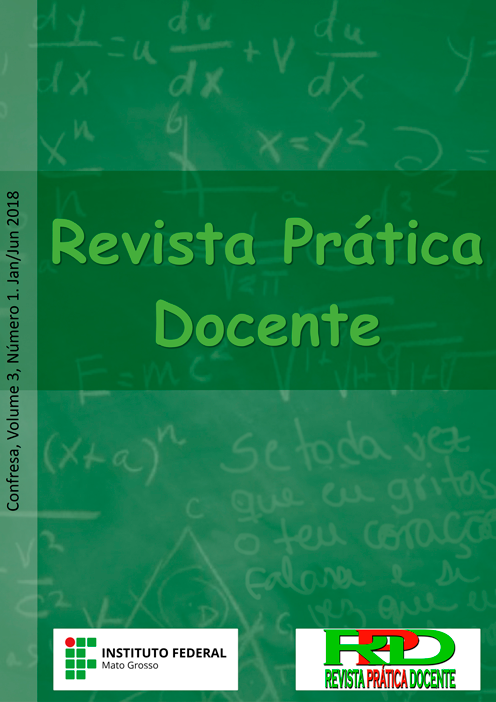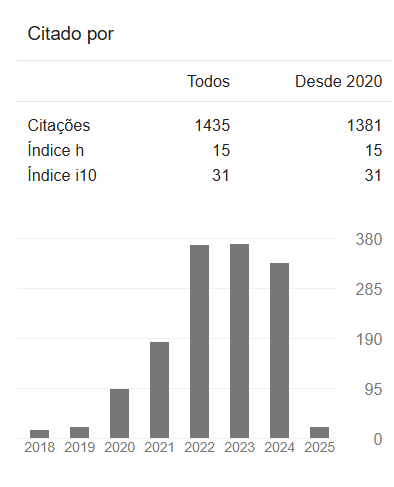FROM CLASSROOM ON CAMP: A FAST COLLECTION OF INFORMATION FOR SHOWING OF FLORISTICAL DIVERSITY OF GREEN AREA IN SORRISO, STATE OF MATO GROSSO
DOI:
10.23926/RPD.2526-2149.2018.v3.n1.p171-179.id148Keywords:
Flora, Teaching, Practical classroomAbstract
From the Botany and Plant Morphology classes, it was fomented the idea of surveying about the richness and composition of vegetal vasculary species in a green area of the Sorriso municipality, north of Mato Grosso State. For the fast collection method, registered in intervals of five minutes, the presence of inedits species wich was encountered. It was identified 47 species, being the Fabaceae family the specie with the largest number of representatives, followed by Arecaceae. The fast collection method is indicated for the floristical information of quality about the vegetation, being an important auxiliary tool on flora’s reliable besides contributes for the futures projects of ambiental management, management plans and restoration of degraded areas can be thought for the implantation of publics politics of conservation of vegetable communities of the city.
Downloads
Metrics
References
APG (Angiosperm Phylogeny Group) III. 2009. An update of the Angiosperm Phylogeny Group classification for the orders and families of flowering plants: APG III. Botanical Journal of Linnean Society 161: 105-121. DOI: https://doi.org/10.1111/j.1095-8339.2009.00996.x
BRITO, E. R.; SOARES, T. S. Valores econômicos, sociais e pessoais dos estudos descritivos da vegetação. Revista Científica Eletrônica de Engenharia Florestal, FAEF 4:1-13. 2006.
CAVASSAN, O.; PINHEIRO DA SILVA, P. G. ; SENICIATO, T. O ensino de Ciências, a biodiversidade e o Cerrado. In Divulgação Científica e Ensino de Ciências: Estudos e Experiências. Escrituras, São Paulo, p.190-219. 2006.
FARIA, R. L.; JACOBUCCI, D. F. C.; OLIVEIRA, R. C. Possibilidade de ensino de Botânica em um espaço não formal de Educação na percepção de professoras de Ciências. Rev. Ensaio. Belo Horizonte. v. 13., n. 01., p. 87-104, jan-abr, 2011. DOI: https://doi.org/10.1590/1983-21172013130107
FILGUEIRAS, T. S.; BROCHADO, A. L.; NOGUEIRA, P.E.; GUALA II, G. F. Caminhamento – um método expedito para levantamentos florísticos qualitativos. Cadernos de Geociências, v.2, n.4, p.39–43, 1994.
FILGUEIRAS, T. S. Herbaceous plant communities. In: P.S. Oliveira & J.R. Marquis (eds.). The cerrado of Brazil: Ecology and natural history of a neotropical savanna. Columbia University Press, New York, pp. 121-139. 2002. DOI: https://doi.org/10.7312/oliv12042-008
FRANÇA, M. S.; GOMES, E. S. Indícios de ilha de calor urbana em Sorriso/MT. REMOA – Revista Monografias Ambientais – UFSM, Santa Maria, RS. v.14, n.3, p. 3366-3376. maio./ago.2014. DOI: https://doi.org/10.5902/2236130813401
GOHN, M. G. Educação não-formal, participação da sociedade civil e estruturas colegiadas nas escolas. Ensaio: Avaliação e Políticas Públicas em Educação, v. 14, n. 50, p. 27-38, 2006. DOI: https://doi.org/10.1590/S0104-40362006000100003
GUEDES-BRUNI, R.R., PESSOA, S.V.A.; KURTZ, B.C. 1997. Florística e estrutura do componente arbustivo-arbóreo de um trecho preservado de floresta montana na Reserva Ecológica de Macaé de Cima. In: Lima, H.C. de & Guedes-Bruni, R.R. (eds.). Serra de Macaé de Cima: Diversidade florística e conservação em Mata Atlântica. Rio de Janeiro, Jardim Botânico do Rio de Janeiro. p. 27-145.
HARRI, L. Árvores Brasileiras. Manual de identificação e cultivo de plantas arbóreas nativas do Brasil. 3. ed. v.2. São Paulo: Plantarum, 2009.
ISHARA, K. L. Aspectos florísticos e estruturais de três fisionomias de cerrado no município de Pratânia, São Paulo.Tese (doutorado).Instituto de Biociências de Botucatu, Universidade Estadual Paulista, 2010.
KINOSHITA, L. S.; TORRES, R. B.; TAMASHIRO, J. Y., FORNI-MARTINS, E. R.. A Botânica no Ensino Básico: relatos de uma experiência transformadora. São Paulo: Rima, 2006. 162 p.
LOMBARDO, M. A. Vegetação e clima. In: ENCONTRO NACIONAL SOBRE ARBORIZAÇÃO URBANA, 1990, Curitiba. Anais... Curitiba: FUPEF, 1990. 368 p.
MARTINS, F. R.. O papel da fitossociologia na conservação e na bioprospecção. In Anais do 55º Congresso Nacional de Botânica.Viçosa. 2004.
RATTER, J. A.; B.S.; RIBEIRO, J. F. Analysis of floristic composition of the Brazilian cerrado vegetation III: comparison of the woody vegetation of 376 areas. Edingurgh Journal of Botany 60(1): 57-109. 2003. DOI: https://doi.org/10.1017/S0960428603000064
RISSI, M. N.; CAVASSAN, O. Uma proposta de material didático baseado nas espécies de Vochysiaceae existentes em uma trilha no Cerrado. Biota Neotrop. v. 13, n. 1. Campinas. jan./mar. 2013. DOI: https://doi.org/10.1590/S1676-06032013000100003
RIZZINI, C. T. Tratado de fitogeografia do Brasil: Aspectos ecológicos, sociológicos e florísticos. 2. ed. Rio de Janeiro: Âmbito Cultural, 1992, 747.
RODRIGUES, M. T. A biodiversidade dos cerrados: conhecimento atual e perspectivas, com uma hipótese sobre o papel das matas de galerias na troca faunística durante ciclos climáticos. In: A. Scariot, J.C. Sousa-Silva & J.M. Felfili (orgs.). Cerrado: Ecologia, Biodiversidade e Conservação. Ministério do Meio Ambiente, Brasília, pp. 235-246. 2005.
SAMMARCO, Y. M. Educación ambiental y paisaje en los espacios naturales protegidos de Brasil: contribuiciones a la construcción del documento Encea (Estrategias Nacionales de comunicación y EA para el SNUC). In: MEIRA-CARTEA, P. A. et al. Educación ambiental: investigando sobre la práctica. Organismo Autónomo Parques Nacionales, 2009. p. 202-225.
WALTER, B. M. T.; GUARINO, E. S. G. Comparação do método de parcelas com o “levantamento rápido” para amostragem da vegetação arbórea do Cerrado sentido restrito. Acta botânica brasileira. v. 20, n 2, p 285-297. 2006. DOI: https://doi.org/10.1590/S0102-33062006000200005
Downloads
Published
How to Cite
Issue
Section
License
Copyright (c) 2023 A Revista Prática Docente tem o direito de primeira publicação

This work is licensed under a Creative Commons Attribution-NonCommercial 4.0 International License.
Authors who publish in this journal agree to the following terms:
- Authors retain the copyright and grant the journal the right of first publication, with the paper simultaneously licensed under the Licença Creative Commons Attribution allows the sharing of the work with acknowledgment of authorship and initial publication in this journal.
- Authors are authorized to take additional contracts separately, for non-exclusive distribution of the version of the work published in this journal (e.g. publish in institutional repository or as a book chapter), with acknowledgment of authorship and initial publication in this journal.











